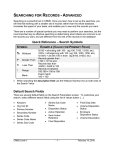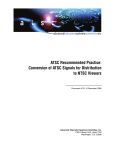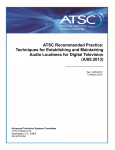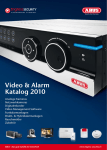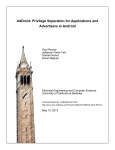Download Draft 1 V7.0 Comment Summary and Response
Transcript
Draft 1 ENERGY STAR Version 7.0 Televisions Specification Comment-summary Document Topic Subtopic Stakeholders Comment Summary Two stakeholders expressed support for EPA’s effort to harmonize with the U.S. Department of Energy Appendix H to Subpart B of 10 CFR § 430 as it streamlines the testing process and provides clear direction for Partners. U.S. Environmental Protection Agency Response EPA will maintain harmonization with the U.S. Department of Energy Appendix H to Subpart B of 10 CFR 430. Definitions General Two stakeholders expressed support for removing the definitions for Rear-projection, Direct-view, Analog, and Combination TVs. However, one stakeholder noted that Component TVs may briefly re-enter the market when ATSC 3.0 is launched. EPA will continue to exclude the definitions for Rear-Projection, Direct-View, Analog, Combination, and Component TVs but per the stakeholder comment welcomes examples of Component TVs to track their relevance on the market. Definitions Basic Model Two stakeholders agreed with replacing the Version 6.0/6.1 Product Family definition with the Basic Model definition in 10 CFR 430, Subpart A, Section 430.2. EPA will maintain the Basic Model definition. Definitions Default Picture Setting One stakeholder noted that the Default Picture Setting definition in the current draft differs from the definition in CEA-2037-A and in the upcoming IEC 62087-3 standard. In the Retail Configuration, the Default Picture Setting is known as the "Retail Picture Setting," whereas in the Draft 1 Version 7 specification, Default Picture Setting can refer to either the Home or Retail Configurations resulting in potential confusion. The stakeholder recommended reviewing the conceptual framework in the above standards which show the relationships clearly. For reference and greater clarity, EPA has proposed inclusion of diagrams from the DOE Final Rule illustrating how the picture setting definitions. To ensure harmonization with the U.S. Department of Energy Appendix H to Subpart B of 10 CFR § 430, EPA will maintain the current definition. Definitions Screen Area One stakeholder agreed that area measurement of curved screens is necessary and agrees with the proposed definition. EPA will maintain the updated Screen Area definition to accommodate curved TVs. Definitions Effective Vertical Resolution Three stakeholders expressed support for the inclusion of the Effective Vertical Resolution definition. One stakeholder also noted that "addressability" is a term that can be used rather than "native resolution" (e.g. 3840 x 2160 pixels or higher addressability). Another stakeholder requested that the additional test and requirements for Effective Vertical Resolution be clearly described. Harmonization with Final Rule In Draft 1, EPA proposed the inclusion of a device-independent definition of resolution, “Effective Vertical Resolution,” and referenced the Society for Information Displays (SID) Information Displays Measurement Standard Version 1.03. This standard provides a means for determining effective resolution that does not rely on physical structure, and instead focuses on objective measurements of performance which relate to human visual perception. This approach uses an alternating high contrast band (>50% Michelson contrast (“contrast modulation”) in both vertical and horizontal). See section 7.8: http://www.sid.org/Publications.aspx EPA thanks stakeholders for proposing "addressability" as a term used to describe TVs capable of displaying UHD content. However, it is EPA's understanding that this term refers to the input of the TV and not necessarily the output picture of the TV. EPA also received mixed feedback about the use of Native versus Effective Vertical Resolution to categorize higher resolution TVs. Despite support for the definition, it was not clear whether it would be used in practice, nor did EPA receive data or examples of models that have a different Effective Resolution from Native Resolution (physical pixel count). EPA is therefore proposing to use only Native Resolution consistent with the existing and previous TV ENERGY STAR specifications. EPA welcomes feedback on this approach, as well as in subsequent sections that relate to higher resolution models such as TVs marketed as UHD. Page 1 of 8 Draft 1 ENERGY STAR Version 7.0 Televisions Specification Comment-summary Document Topic Definitions Subtopic Ultra High Definition Stakeholders Comment Summary Two stakeholders suggested that EPA align the specification definition with the Consumer Electronics Association (CEA) UHD definition. CEA's definition does not include a reference to frame rate or the additional test proposed by EPA in Draft 1 but does require the following characteristics: • Display Resolution—Has at least 8 million active pixels, with at least 3840 horizontally and at least 2160 vertically. • Aspect Ratio—The width to height ratio of the display’s native resolution is 16:9 or wider. • Upconversion – The display is capable of upscaling HD video and displaying it at Ultra High‐Definition display resolution. • Digital Input – Has one or more HDMI inputs supporting at least 3840x2160 native content resolution at 24p, 30p, & 60p frames per second. At least one of the 3840x2160 HDMI inputs shall support HDCP v2.2 or equivalent content protection. • Colorimetry – Processes 2160p video inputs encoded according to ITU‐R BT.709 color space, and may support wider colorimetry standards. • Bit Depth – Has a minimum bit depth of 8 bits. One stakeholder noted that CEA continues to revise and update its definition of Ultra HD as the technology evolves also suggested that the UHD definition include “8K” in addition to “4K” resolution. U.S. Environmental Protection Agency Response EPA has considered the latest CEA definition for UHD but proposes not to include it in the Version 7 specification at this time. Since the CEA definition may be subject to change over the coming years to adopt other emerging technologies, such as High Dynamic Range, EPA proposes waiting until UHD characteristics become standardized and are widely adopted by the market, as seen with the development of HD, before referencing a definition. In order to simplify the specification, with Draft 2 EPA is proposing to remove a separate definition for UHD and simply specify that TVs that have at least 2160 pixel Native Vertical Resolution be eligible for a separate power allowance. This proposal removes the frame rate requirements which are not included under CEA and reflects a similar approach to how EPA structured previous ENERGY STAR specifications when HD started taking off in the market. Definitions Wake On LAN One stakeholder expressed support for adding the Wake-On-LAN definition and suggested a related definition for Wake-On-Wireless LAN (WoWLAN). Another stakeholder requested that this function not be required for viewing TV and that it instead remain categorized as a special function. EPA is proposing to not include Wake-On-LAN and Wake-on-Wireless definitions in the Draft 2 because these functionalities will not be distinguished from the functionality confirmed under the Full Network Connectivity test procedures and when applying the Standby-Active, Low power requirements to a TV. EPA did not receive feedback that Wake-On-LAN or WoWLAN require additional power, so for simplicity EPA will exclude it from the Definitions section. Definitions Gesture and Voice Recognition Two stakeholders inquired whether DOE and EPA have plans to test gesture and voice recognition features and whether consideration will be given if they save energy. Another stakeholder questioned whether gesture and voice recognition require significant additional power in On Mode. Based on discussions with industry stakeholders and available information, it does not appear that gesture and voice recognition features require significant additional power in On Mode. As a result, EPA does not propose testing or providing additional allowances for these features under the Version 7.0 specification. Nevertheless, EPA proposes to include the definitions so that Partners are able to report these features to consumers. EPA will continue to monitor the prevalence of these features in the market and seek information regarding their energy consumption to determine if they should be further addressed under future specification revisions. Definitions High Efficiency Video Processing One stakeholder questioned the need for an HEVC definition as the HEVC decoders do In response to feedback, EPA proposes to remove the High Efficiency Video Processing definition. not consume significant power compared to other decoder technology, such as MPEG-2 EPA anticipates that UHD TVs with Thin Client Capability will include this technology, so there is not a need to specifically call it out on the ENERGY STAR Certified Products List, as Thin Client and AVC. Another stakeholder commented that reporting HEVC is unnecessary. Capability will already be highlighted. Definitions Modes One stakeholder noted that CEA-2037-A and the upcoming IEC 62087 have slightly different wording than the Draft 1 specification, but the meaning is harmonized. Definitions Two stakeholders agreed with the Multichannel Video Programming Distributor (MVPD) Multichannel Video definition. Programming Distributor (MVPD) Point of Deployment Module Two stakeholders commented that a definition for Point of Deployment Module (POD) is no longer needed. The market did not support the additional hardware cost of adding POD support to TVs so its presence is declining. If MVPD client support in televisions is to succeed, the stakeholder believes that the conditional access feature must be provided by downloadable software rather than modular, removable hardware. The CableCARD specification requires significant power to be made available to the CableCARD slot which can force the selection of a larger power supply than otherwise needed, and this might reduce efficiency. EPA will maintain the definition for Multichannel Video Programming Distributor. Power Overhang State Despite stakeholder feedback, EPA is removing the definition and power requirements for Power Overhang State because the Agency understands that the functions previously delivered in this state, including quick start, are now delivered in one of the Standby modes as defined in this specification. Definitions Definitions One stakeholder commented that the definition of Power Overhang State should not be removed and that the concept may prove useful in future discussions about standby power, quick start, etc. Page 2 of 8 EPA thanks the stakeholder for noting the minor difference. In an effort to harmonize with the U.S. Department of Energy (DOE) Appendix H to Subpart B of 10 CFR § 430, EPA will maintain the definitions. In light of stakeholder comments that Point of Deployment Modules in their current form are declining on the market and nearly non-existent on the current ENERGY STAR certified products list, EPA proposes to remove the definition from the Version 7 specification. Draft 1 ENERGY STAR Version 7.0 Televisions Specification Comment-summary Document Topic Subtopic Stakeholders Comment Summary Stakeholders expressed general support for the revisions proposed to the Included Products language in Draft 1. Scope: Excluded Products TVs with Main Battery Two stakeholders expressed support for removing TVs powered with a Main Battery from Given that EPA received no stakeholder feedback opposing this change, that there are no ENERGY the scope of the ENERGY STAR specification. Another stakeholder noted that CEA-2037- STAR-certified battery operated-TVs currently, and the inherent incentive for battery-operated TVs to save energy, EPA retains the proposal to exclude TVs with Main Batteries in line with the scope of the A and the upcoming IEC 62087-3 standard allow testing of TVs with main batteries if DOE Appendix H to Subpart B of 10 CFR Part 430. those main batteries can be removed. By performing all measurements with the main batteries removed, the televisions can be tested in the same manner as ac mainspowered televisions. This stakeholder suggested that EPA limit the exclusion to TVs with non-removable Main Batteries. Scope: Excluded Products Computer Monitors without One stakeholder expressed support for the exclusion of Computer Monitors without TV a TV Tuner tuners. EPA will retain the scope exclusion for Computer Monitors without TV tuners. EPA notes that these products will be considered under the Version 7.0 Displays specification development. Scope: Excluded Products TVs with no StandbyPassive, Mode Two stakeholders expressed support for removing the scope exclusion for TVs with no Standby-Passive Mode including TVs with PublicAlert certification. One stakeholder reiterated that products that do not have Standby-Passive Mode could still be ENERGY STAR certified with this change. EPA confirms that that TVs that do not have Standby-Passive Mode are still eligible for ENERGY STAR certification provided that they meet the Standby-Active, Low power requirements. External Power Supplies Requirements Two stakeholders agreed with the updates to the External Power Supply (EPS) efficiency EPA has updated the EPS requirements to reflect the energy conservation standards adopted by requirements with one noting that clearly EPSs must meet U.S. federal regulations. DOE earlier this year, and which cover both single- and multiple-voltage EPSs will take effect on February 10, 2016. Scope: Included Products Thin Client Capability U.S. Environmental Protection Agency Response EPA will maintain the proposed Included Products language. Stakeholders expressed support for the definition and consideration of Thin Client Capability within the Version 7.0 specification. Several stakeholders noted that the net effect of replacing a set-top box with a TV with Thin Client Capability is not well understood and recommended that EPA not include any power allowance under Version 7.0 for this feature. Stakeholders urged EPA to consider conducting additional studies to better characterize its energy saving potential. Conversely, two other stakeholders suggested EPA include a power allowance to further incentivize adoption. Based on stakeholder feedback and lack of available data on the energy performance of Thin Client Capability within a TV, EPA is not proposing to include any power allowance or other incentive for TVs with Thin Client Capability under Version 7.0. As a growing segment of "smart TVs" are beginning to feature Thin Client Capability, EPA seeks to provide consumers, retailers, and energy efficiency program sponsors with basic information regarding this capability to increase awareness of potential benefits. Once more is understood about this feature, EPA will seek more data to better quantify any benefits and consider addressing them in a future revision, if necessary. Several stakeholders expressed support for EPA’s intention to offer ENERGY STAR Partners the ability to highlight Thin Client Capability on the ENERGY STAR certified products list, noting that it 1) would be seen by consumers as allowing for a receiver-less installation and 2) could enable additional consideration in utilities' energy efficient TV promotions. One stakeholder recommended that this functionality should be listed in both the user manual and via an on-screen prompt with the website to receive more information about compatible service providers as well as an explanation outlining benefits of using Thin Client Capability instead of traditional set-top-boxes. EPA is retaining the following Draft 1 proposed requirement as follows: "i. Report the presence of Thin Client Capability and supporting information including, but not limited to, interoperability protocols, decryption, and decoding functions for display on the ENERGY STAR certified products list; and ii. Inform the consumer in the user manual and/or on-screen prompt that the TV may be capable of operating without a set-top box from a MVPD." One stakeholder noted that each Thin Client Capable technology that EPA chooses to recognize must allow for the full home media server experience to be conveyed, as if the TV was connected directly to the server via an HDMI cable and be an open standard available to be implemented by any manufacturer (e.g., it cannot be proprietary to a particular Pay-TV provider or TV manufacturer). Of the industry standards identified by the EPA in Draft 1, RVU and DLNA CVP2 meet these criteria. Three stakeholders noted that reporting all of the technical capabilities of Thin Client Capability would be prohibitively complex and that open standard certifications may not be approved at the time of ENERGY STAR certification, thus they recommend EPA not make reporting a requirement. As products are brought to market, there are often several ongoing processes required before the TV can be sold, such as certifications that may be required for thin client capability. Thin client certifications may not be complete at the time the product is submitted for ENERGY STAR certification. Page 3 of 8 Given regional variations and the ever-changing content delivery landscape, EPA proposes a flexible and broad informational requirement and encourages TV manufacturers and MVPDs to provide additional information and resources to consumers. Finally, EPA notes that manufacturers who have not yet finalized certifications to standards may have their EPA-recognized certification bodies update their product data at any time. The TV will still be eligible for ENERGY STAR certification even if the industry standard (RVU, DLNA CVP-2) certification is not complete and the manufacturer reports that the standard is not available at the time of ENERGY STAR certification and subsequently updates the data at a later time. To assist Partners in seeing how this proposed reporting requirement could appear, EPA has included with this Draft 2 specification a Draft Version 7 Qualified Product Exchange (QPX) template for stakeholder review. Draft 1 ENERGY STAR Version 7.0 Televisions Specification Comment-summary Document Topic Subtopic On-screen Information Standby Passive and Timer Standby Active, Low Requirements Stakeholders Comment Summary In agreement that consumers should be informed about features and functions that can affect the power consumption of the television, two stakeholders supported on-screen information requirements for changes in Standby Mode settings provided that generic energy savings language is allowed and the use of “ENERGY STAR” is not required (for all of Section 3.2 including picture settings). The stakeholders suggested display language that reads "may increase the energy consumption of your product," or the like, that will not necessitate costly software and user interface modifications for products that fail to meet a future specification or when a design modification causes the product to consume more energy. Two other stakeholders expressed support for on-screen information requirements similar to Section 3.2.4 Preset Picture Setting Menu, such as including the ENERGY STAR mark in the name or description of the default as-tested setting or in the form of a message displayed each time any setting other than the default as-tested setting is selected. U.S. Environmental Protection Agency Response EPA is proposing to keep the existing requirement Section 3.2.4 Picture Setting Requirements. Under Version 6.0/6.1, over 65% of models include on-screen information about "ENERGY STAR" and over 70% provide a second prompt confirming a consumers' decision to switch from the default picture setting. EPA recognizes that the picture setting requirements provides some flexibility in how and if the "ENERGY STAR mark" is used while still informing consumers, and therefore, proposes to extend this approach to Standby Mode information requirements. One stakeholder noted that experience with game consoles shows additional features can significantly increase energy use in standby and therefore recommended that EPA require manufacturers to set a default time (5 PM to 10 PM) for which features would be enabled. This approach asks the user to opt out rather than in, thus ensuring greater adoption of such a timer and therefore higher energy savings. As a result of challenges in implementing a timer requirement, EPA has reconsidered this approach. With more network enabled and feature-rich TVs entering the market in the next couple of years, EPA expects that many TV features such as quick start will be enabled by default or prompted in a Forced Menu and thus captured under Standby-Active, Low and Standby-Passive Modes tests, ensuring that TVs with these features are evaluated against ENERGY STAR requirements. For those features that are not enabled in the as-tested configuration, EPA believes the above proposed on-screen requirements enable the consumer to optimally use the TV in a way that reduces energy waste. In contrast, three stakeholders opposed the timer requirement pointing out that not all TVs have an active internal clock capable of maintaining time in event of power loss, implementation is not standardized across manufacturers, and the U.S. DOE Annual Energy Consumption equation does not incorporate any Standby-Passive Modes the model may enter in the event a clock de- and re-actives network functions. One of these stakeholders commented that if EPA decides to keep this concept it should be in the form of an incentive and not a requirement. Standby-Active, High Mode One stakeholder expressed opposition to the requirement that the TV return to StandbyActive, Low mode following a firmware update or other maintenance operation because it does not take into account TVs designed to enter alternate modes such as StandbyPassive mode or other settings and it may limit older TVs from being updated to include newer features. EPA also notes that settings in Standby Mode may include a wide variety of features (human interfaces, applications, timers, network connections, etc.) and be presented in a less straightforward manner than Picture Settings. To allow for flexibility, EPA is proposing that Partners may meet Standby Mode on-screen informational requirements by including ENERGY STAR messaging next to the default as-shipped configuration or a more general message such as "this selection may change the energy consumption of your product." EPA has modified the requirement such that TVs return to a Standby Passive or Standby-Active, Low Mode rather than remaining in a higher power Standby-Active, High Mode following a firmware update or delivering other functionality, such as quick start. For purposes of third-party certification, the time within which the TV returns to the default as-tested stand-by active, low mode shall be reported by the Partner to the EPA-recognized certification body, however, documentation shall not be reviewed when products are certified or during verification testing. EPA reserves the right to request this documentation at any time. Another stakeholder asked that EPA align with DOE’s test procedure and not include requirements or test methods for Standby-Active, High Mode. Similarly, a third stakeholder did agree that the TV should enter Standby-Active, Low or Standby-Passive EPA and DOE will also consider how to further address Standby-Active, High Mode under future Mode; however, they argued that it is not easily testable by a 3rd party so it is not an specification developments once more information on this function/mode transition becomes appropriate requirement and EPA should only suggest the behavior. A fourth stakeholder available. asked that it be modified to include either Standby-Active, Low or Standby-Passive mode if it is to be made a requirement. Page 4 of 8 Draft 1 ENERGY STAR Version 7.0 Televisions Specification Comment-summary Document Topic On Mode Power Requirements Subtopic High Definition Stakeholders Comment Summary Several stakeholders commented that the Draft 1 On Mode Power criterion for High Definition (HD) TVs is too strict capturing only 15% of models in the Version 6.0/6.1 database whereas 20-25% would be more appropriate: • Unlike in previous years, the rapid decline in TV On Mode power may be limited by a more mature LCD technology. • Two manufacturers indicated that the calculated interpolated data for Notice of Proposed Rule Making tested products are lower in power than actual measured data using the DOE Final Rule test method. They suggested the EPA perform a new analysis based on models certified to Version 6.1 with the Final Rule test method. • Compared to several models meeting in the small and medium size bins, one stakeholder noted that only one 70 inch TV meets the V7 Draft 1 proposal and that the criteria should not penalize TVs is the 70, 80, and 90 inch size bins. In contrast, two stakeholders commended EPA for its forward-looking approach in developing On Mode Power requirements and recommended more stringent requirements by reducing the pass rate to 10% to account for the fact that there are 1-2 product cycles between now and the specification effective date in late 2015. By the time the Version 6 specification took effect in June 2013, the stakeholder estimated that it had over 75% market penetration. As of May 2014, Version 6 has an estimated market penetration of over 85%. On Mode Power Requirements Ultra High Definition Two stakeholders encouraged EPA to set realistic UHD allowances that nonetheless help select the more efficient UHD TVs currently in the market. One of these stakeholders noted that Ultra High Definition (UHD) televisions are expected to gain significant market share over the next few years with sales rapidly growing in the largest size bins. According to DisplaySearch, unit shipments of UHD TV models are expected to increase by roughly 10x from 2013-17. Within the >60” TV size bin, UHD market penetration increased almost 100x over the past year from 0.1% in 2013 to 9.4% in 2014. This stakeholder further recommended a UHD allowance decrease over time so that manufacturers are incentivized to decrease UHD energy consumption with each UHD generation. In addition, the stakeholder recommended that EPA work with industry to develop an UHD test procedure. Other stakeholders commented that UHD TVs require a greater power allowance than HD TVs given the following: • Wide Color Gamut and High Dynamic Range due to the BT2012 4K Broadcasting System Standard • UHD (4K) TVs also require four times the amount of memory and a corresponding increase in processing speed to support four times as many pixels as compared to HD • UHD TVs will employ HEVC decoding which also requires greater power for signal processing • Aperture ratio in some UHD panels may be smaller compared to HD panels passing through less light • Advanced audio systems • Dimming circuits Noting that UHD TVs can use twice the power of HD TVs, stakeholders pointed out that the EPA dataset for UHD does not appear consistent with typical 4k models currently available: the power was lower than expected for non-ABC and two models appear not to be available on the U.S. market. Page 5 of 8 U.S. Environmental Protection Agency Response In response to the On Mode Power levels for HD TVs in EPA’s Draft 1 proposal, a few stakeholders stated, with supporting data, that EPA’s estimated On Mode power of Version 6.0 ABC models, calculated through linear interpolation of power measurements at the NOPR illuminance test points (0, 10, 50, 100, and 300 lux) to approximate power at the Final Rule illuminance test points (3, 12, 35, and 100 lux), was too low. Thus, for Draft 2, EPA conducted new analyses of its dataset removing the interpolated ABC models. The revised dataset represents 764 unique models and includes 112 ABC models certified to Version 6.1 and tested to the Final Rule DOE Test Procedure with the remainder non-ABC models certified to both Version 6.0 and 6.1, since the reported power values of non-ABC models were not affected by the Final Rule DOE Test Procedure. Based on this updated dataset, EPA proposes new levels that capture approximately 16 percent of models in the dataset across a variety of sizes. At least 10 major manufacturers have one or more models meeting the new proposed criteria. With this proposal, EPA still intends to capture the top performing when the specification takes effect. In response to questions posed in Draft 1, EPA obtained data on 63 current and forthcoming UHD models from manufacturers and the California Energy Commission database. Data indicate that while most UHD models consume considerably more energy than HD models, a few stand out as being significantly more efficient than their counterparts. EPA seeks to recognize only top performing UHD models, aiming to incentivize improvements in efficiency across other models in the near future. The data further indicate that UHD TV On Mode Power increases with screen size in a similar manner as HD TVs. Therefore, to capture the most efficient UHD TVs, EPA proposes an adder of 55% of the maximum On Mode Power requirement. EPA proposes this adder be proportional to On Mode power as calculated based on screen area, recognizing that the UHD impact on energy use will be experienced across the total screen area. With this adder, three manufacturers have products that would be eligible for the ENERGY STAR. Recognizing that UHD is new to the market, and TV partners have an impressive record of dialing back the power use of new features, EPA proposes that the adder expire on May 1, 2017. In response to stakeholder feedback during the Draft 1 webinar on the energy use of UHD models, EPA and DOE are still interested in understanding differences in power consumption due to the processing power needed to upscale 2K content to 4K content. EPA and DOE encourage stakeholders to provide additional data as they become available. Draft 1 ENERGY STAR Version 7.0 Televisions Specification Comment-summary Document Topic On Mode Power Requirements Subtopic 3D Stakeholders Comment Summary Based on one stakeholder’s analysis of the CEC Appliance Efficiency Standards dataset, only 10% of TVs with 3D capability meet ENERGY STAR Version 6 requirements, and they consume substantially more energy than non-3D enabled televisions when viewing standard HD content. It is unclear why this increase is occurring since the televisions are being tested with a standard TV broadcast test clip. The stakeholder recommended that EPA investigate this further and, if verified, identify strategies for reducing power draw of 3D televisions while viewing standard 2D content. U.S. Environmental Protection Agency Response EPA notes that 15 of the 24 3D TVs tested to the Final Rule, representing the newest models on the market, meet the Draft 2 Version 7 On Mode Power requirements. These data indicate that the most efficient 3D capable TVs do not use significantly more power than non-3D TVs to display 2D content. Similarly, another stakeholder commented that it is still disconcerting that the current test procedure does not test 3D TVs in 3D mode and as such, those certified televisions may be using significantly more energy. For Version 7, the stakeholder suggested EPA analyze the number of 3D TVs meeting the requirements and ensure the energy consumption in 3D mode is kept in alignment with the goals set forward by EPA. Standby-Passive Mode Requirements Five stakeholders expressed support for lowering the Standby-Passive Mode power limit EPA thanks stakeholders for their comment on the 0.5 W power limit proposal for Standby-Passive to 0.5 W from 1.0 W. Mode and has retained it in Draft 2. Standby-Active, Low Full Network Connectivity Mode Test Procedures Stakeholders expressed support for the inclusion of the CEA-2037-A Section 6.7.5 to confirm Full Network Connectivity given that it is not confirmed in the 10 CFR § 430 test procedures and power control with an external signal is commonly done over IP for modern TVs. There was consensus that by definition Standby-Active, Low Mode should have Full Network Connectivity making the distinction between the two unnecessary. Since the test only covers Ethernet and Wi-Fi, one stakeholder commented that there should be a provision for Hospitality TVs which communicate over coaxial cable, RJ11, etc. interfaces using proprietary protocols. Hospitality TVs use a variety of activated hospitality protocol software such as Multiple Television Interface (MTI) to provide direct access to Video-On-Demand (VOD) systems or a digital media player designed for hospitality-specific applications. The stakeholder suggested that the easiest way to test Standby-Active, Low Mode for hospitality televisions may be to simply stop the DAM communication during the DAM test. The network should stay connected, but the downloading/uploading of data (DAM) would not be occurring in the Standby-Active, Low Mode. Page 6 of 8 EPA and DOE agree that the distinction of Standby-Active, Low Mode WITH and WITHOUT Full Network Connectivity is unnecessary and has thus removed it from the Draft 2 specification. To ensure that the specification captures all functions of Hospitality TVs, EPA and DOE propose that Hospitality TVs also test Full Network Connectivity separate from the Download Acquisition Mode test. EPA and DOE seek stakeholder feedback on this proposal. Draft 1 ENERGY STAR Version 7.0 Televisions Specification Comment-summary Document Topic Subtopic Standby-Active, Low Power Requirements Mode Stakeholders Comment Summary Stakeholders argued that a 1.0 W Standby-Active, Low Mode power requirement applied to a TV actually providing Full Network Connectivity is too stringent and that a requirement in the range of 3.0 W to 6.0 W (including aligning with European Union (EU) Network Standby regulations) would be more appropriate. Supporting points included: • Existing ENERGY STAR certified Standby-Active, Low Mode power data is not reflective of the TV providing Full Network Connectivity, rather the TV is only maintaining connection at the physical layer. Therefore EPA should collect additional data though not many models today ship with the capability; • One stakeholder’s experimental data suggests that power levels of 1 to 6 W may be required for this mode. Another stakeholder’s analysis shows levels 0.5 W and 3 W are required to maintain Full Network Connectivity; and • As televisions are increasingly becoming "feature-rich" and provide many more applications to allow interaction with other devices, anticipate that more energy will be required. U.S. Environmental Protection Agency Response Based on stakeholder feedback on the power allowances needed to maintain a network presence, and still taking into account how other efficient products perform in networked low power states, EPA proposes revising the Standby-Active, Low requirement from a 1.0 W allowance to a 3.0 W allowance. EPA also notes that manufacturers will have to meet the EU 3.0 W power limits for network standby in 2017. One stakeholder noted that potential conflict with other regulations in place may prevent manufacturers from deploying certain features and functions in Standby-Active, Low mode. Two additional stakeholders commented that EPA’s efforts to develop requirements for network connectivity are important to encourage the most efficient implementation and cautioned EPA not to be influenced by claims of technological limitations. One stakeholder illustrated that there is a dramatic range of Standby-Active, Low mode power in the EPA dataset: 10 to 70 W seeming to correlate with screen size. By definition, Standby-Active, Low mode does not include the transmission of data from an external source, which suggests that this increase in power is due to an internal setting which is keeping the TV active, possibly the Quick Start menu. They therefore recommended that EPA further investigate the root cause of this increased power draw and incorporate measures in the specification to actively address it. Standby-Active, Low Default Mode Requirement One stakeholder expressed support for removing the following Version 6.1 Section 3.5.1 EPA has removed the Section 3.5.1 from the Draft 2 Version 7.0 specification. Standby-Active, Low requirement: "For products that offer more than one functionality in Standby-Active, Low Mode, the Standby-Active, Low Mode with the lowest power consumption shall be enabled by default, turning on other functionality only when provisioned/enabled by the user." Power Overhang State Two stakeholders agreed that with removing the definition and power requirements for Power Overhang State. Another stakeholder commented that the definition of Power Overhang State should not be removed since the concept may prove useful in future discussions about Standby power, Quick Start, etc. Based on stakeholder feedback, EPA is removing the definition and power requirements for Power Overhang State because the Agency understands that the functions previously delivered in this state, including quick start, are now delivered in one of the Standby modes as defined in this specification. Luminance Requirements Three manufacturers argued that the existing requirement that luminance in the Default Picture Setting be at least 65% of that in the Brightest Selectable Picture Setting is unnecessary, limits manufacturers’ ability to deliver a more optimal viewing experience for consumers at home, and penalizes efficient bright televisions. Bright TVs at retail sell well, so manufacturers are less likely to decrease brightness in the Retail Configuration. One of the stakeholders recommended that TVs be required to either meet the 65% luminance ratio or an absolute level of 100 cd/m2 in the Default Picture Setting noting that 2 Hollywood masters content for the cinema to a peak white level of 50 cd/m and content 2 for home viewing to a peak white level of 100 cd/m . In response to Draft 1, EPA received mixed feedback on whether the luminance requirement is still representative of how products are shipped and used by consumers in the home. Another stakeholder commented that it is their understanding that the 65% threshold has generally prevented a loophole in luminance settings. If that level continues to meet consumer expectations and prevent a manufacturer loophole, then the stakeholder is supportive of this continued level. Approximately 95% of EPA’s dataset has Brightest Selectable Preset Picture Setting luminance 2 below 450 cd/m , and therefore this new proposal would only apply to a small subset of currently certified models. This proposal is intended to still guard against TVs being shipped too dim, while permitting products with brighter maximum screen luminance to be optimized for home use. EPA seeks feedback on this proposal. Page 7 of 8 While most TVs have Brightest Selectable Preset Picture Setting luminance between 200 and 400 2 cd/m , there are some that are brighter. According to some stakeholders, a Default Picture Setting luminance that is 65% of the Brightest Selectable Preset Picture Setting luminance would be too bright for user comfort in these very bright TVs. EPA is therefore proposing that for products with Brightest Selectable Preset Picture Setting luminance of at least 450 cd/m2, the luminance in the 2 2 Default Picture Setting can be no more than 293 cd/m (which is 65% of 450 cd/m ). Draft 1 ENERGY STAR Version 7.0 Televisions Specification Comment-summary Document Topic Hospitality TVs Subtopic Definition and Download Acquisition Mode Testing and Requirements Stakeholders Comment Summary One stakeholder commented that the distinction between hospitality TVs and consumer TVs is still necessary and commented that the existing definition of Hospitality TV is adequate. Another stakeholder noted that Hospitality TVs as defined employ proprietary communication protocols and software to interface with Video‐On‐Demand systems or a digital media player designed for hospitality ‐specific applications. They often utilize coaxial cables, RJ11, etc. for physical network connections. Therefore, their measurement of Standby Active, Low mode requires different test and verification methods than is presently defined for consumer TVs connected via Wi‐Fi or Ethernet using Internet Protocol. U.S. Environmental Protection Agency Response Based on stakeholder feedback on the importance of retaining the definition of Hospitality TVs, EPA also proposes to retain the Download Acquisition Mode (DAM) test. Under Version 7.0, EPA seeks to ensure that all TVs meeting the definition for Hospitality TVs be tested in DAM for certification, if they are capable of doing so. Under Version 6.0/6.1, many Hospitality TVs were tested as consumer models instead. Some Hospitality TVs do resemble consumer models in that they contain Ethernet capability. To ensure that the specification captures the full functions of Hospitality TVs, EPA and DOE propose that, where applicable, Hospitality TVs that have Ethernet capability also test for Full Network Connectivity, according to the test method in Section 4.2.2. in addition to the Download Acquisition Mode test. EPA seeks additional stakeholder feedback on this proposed approach. Two stakeholders expressed support for continuing the use of the CEA Procedure for Download Acquisition Mode (DAM), Rev. 0.3, Sept. 2010 for Hospitality TVs. Conversely, another stakeholder questioned the value of DAM, which can be impossible to test with a black-box approach and may require specialized equipment to simulate real-world operation. The stakeholder supports removing DAM and believes that DAM is not testable by a neutral 3rd party and should not be part of the ENERGY STAR specification. Number of Units Required for Testing One stakeholder expressed support for the choice of sampling plans provided in Draft 1 (both EPA and DOE). EPA will retain the existing options for the number of units required for testing. Effective Date Three other stakeholders requested an effective date of January 1, 2016 instead of late summer 2015 for the following reasons: • Does not align with manufacturer production cycles: Retailers are already actively planning their holiday shelf space allocations at that time so very few new models have first shipment dates in the 4th quarter. Typically, new model year products are introduced in the 2nd and 3rd quarters after being shown for the first time at CES at the start of the 1st quarter. • Lead time not enough if Ultra HD technology is to be accommodated by the specification in a meaningful way. • There are several proposed changes to power levels, functionality, and user interfaces which will require more time to design and implement. EPA will work closely with stakeholders to develop a meaningful specification in a timely manner. Partners are welcome to certify products to the new specification as soon as they are ready-meaning that they can certify to it once it is final or wait until their models are ready. EPA's proposed levels are already achievable by approximately 16% of models in the EPA dataset, which EPA believes to be reasonably reflective of the current market. EPA's experience with this product category indicates that many more models will meet the requirements in the new model year. A fourth stakeholder requested EPA consider adopting an effective date of Sept. 1, 2015. Page 8 of 8










